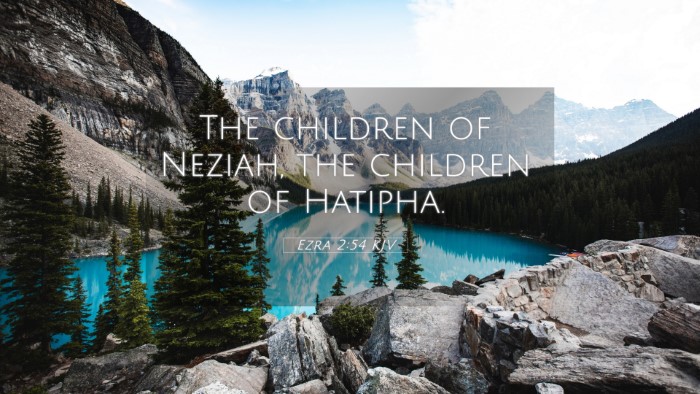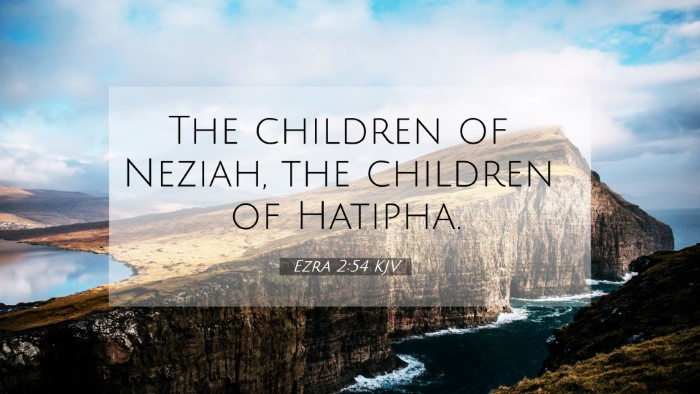Understanding Ezra 2:54
Ezra 2:54 states: "The sons of Solomon’s servants: the sons of Sotai, the sons of Sophereth, the sons of Perida." This verse lists the descendants of Solomon's servants, emphasizing the importance of heritage and service in the community that returned from Babylonian exile.
The context of Ezra 2 involves the returning exiles from Babylon and their organization, which is crucial for rebuilding Jerusalem and the Temple. The listing of names, including those of Solomon's servants, underscores God's faithfulness to His covenant and the restoration of Israel's identity after a period of captivity.
Commentary Insights
Matthew Henry's Commentary
Matthew Henry highlights that this genealogy serves as a reminder of the loyalty and servitude that existed within the Temple's framework. The mention of Solomon's servants indicates the respect and historical significance these workers held within the Jewish community.
Albert Barnes' Notes
Albert Barnes explains the importance of Solomon's servants in that time, suggesting they were integral to temple worship and duties. Their inclusion in this list shows continuity of worship and service that the exiles strived to maintain upon their return.
Adam Clarke's Commentary
Adam Clarke notes that the registration of these names, including those of those who served in the court of Solomon, reflects God's provision for the worship and functioning of the temple. Clarke emphasizes that those listed had specific roles that were foundational for the establishment of religious life for the returning exiles.
Thematic Connections
This verse connects thematically to the ideas of legacy, service, and community in worship. The restoration of Israel was not just about rebuilding physical structures, but also about regaining a sense of identity rooted in the traditions of their ancestors.
Cross-References
- 1 Chronicles 3:10: “And Solomon’s son was Rehoboam…” - This verse traces the lineage, connecting back to Solomon’s household.
- Nehemiah 7:57: “The children of Solomon’s servants…” - A direct reference to the same group, affirming their identity and role.
- 1 Kings 9:22: “But of the children of Israel did Solomon make no bondmen…” - This informs the status of these families as servants, not slaves, which is significant in understanding their role.
- Ezra 2:70: “So the priests, and the Levites, and some of the people dwelt in their cities…” - Highlights the community structure that was being restored.
- Jeremiah 29:10-14: God’s promise for restoration after exile, related to the theme of community rebuilding.
- Ezekiel 37:21-22: A prophecy about restoration and unity among the tribes of Israel.
- Matthew 1:12: A genealogy that includes figures connected to the Davidic line, pointing to the significance of heritage in fulfilling God's plan.
Significance of Cross-Referencing
Understanding and cross-referencing Biblical texts enriches our comprehension of the scriptures. By identifying connections between the Old and New Testaments, we can appreciate the continuity of God’s plan for humanity. For example, Ezra’s emphasis on the servant roles mirrors Christ's teachings on servanthood in the New Testament.
Utilizing tools such as a Bible concordance, Bible cross-reference guide, and systematic methods of cross-referencing Bible study can help believers delve deeper into themes, and understand better how different scriptures interact to provide a cohesive message of redemption and service.
Conclusion
In conclusion, Ezra 2:54 is more than just a list of names; it is a powerful verse that illustrates the fulfillment of God's promises and the importance of community and service in worship. By engaging with this verse through Bible verse cross-references and exploring its thematic connections, readers can garner a more profound understanding of Scripture and its implications for their lives today.


